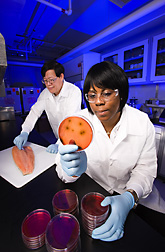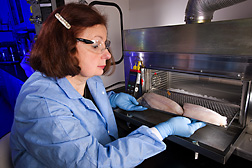In-Demand Fish: Making Sure They’re Always Safe To Eat
|
|
Popular fish like salmon, catfish, and tilapia are coming under the close scrutiny of Agricultural Research Service food-safety scientists Andy Hwang and Kathleen Rajkowski. They’re discovering more about how to prevent foodborne pathogens from contaminating these and other delicious, good-for-you seafood. Both scientists are based at the ARS Eastern Regional Research Center in Wyndmoor, Pennsylvania.
Hwang, a food technologist, has completed a series of studies in which he’s simulated—in his laboratory—commercial processes used today for preparing smoked salmon. A gourmet treat, smoked salmon is typically sold in vacuum packages that have a refrigerator shelf life of about 3 to 8 weeks, according to Hwang. Trouble is, pathogenic microbes like Listeria monocytogenes can live at refrigerated temperatures, so it’s important to get rid of these harmful microbes before the product leaves the processing plant.
Smoked salmon, pricey and, when properly prepared, delicate in texture, is often served in thin slices with bagels and cream cheese or as an appetizer, stacked on toast-type crackers with red onion and a splash of lemon juice. Too, some sushi bars feature smoked salmon surrounded by sticky rice and snugly wrapped in seaweed.
Hwang is looking for ways that processors can protect the pleasing flavor and texture of smoked salmon while reducing or eliminating contamination by L. monocytogenes or other foodborne pathogens.
At the Smokehouse
Smoked salmon is typically prepared by using what’s known as “wet brining” or “dry brining” to cure the raw fillets before smoking. Fish cured with a wet brine are soaked in a solution of water, salt, and sugar, which preserves the fish, helps it retain moisture, and enhances its flavor. The brine may also include spices or liquid smoke, like the kind home chefs use for a backyard barbeque.
With dry brining, the salt and other compounds are rubbed on the fillets and later rinsed off before the fish is smoked.
The smoking process takes place in special smoking ovens in which wood chips are burned to smoke the cured fillets. Most processors opt for cold smoking, which uses temperatures of 68˚F to 86˚F to smoke—but not cook—the fillets. Cold-smoking takes about 3 to 4 days.
Hot-smoking, a lesser-used option for salmon, uses temperatures of about 140˚F and takes about 6 to 10 hours. Hot-smoking cooks the fish, giving it a different taste and texture than cold-smoked fish.
|
|
Many Combinations Tested
In a series of experiments, Hwang and colleagues Shiowshuh Sheen and Vijay Juneja at Wyndmoor exposed cooked salmon samples, prepared with various concentrations of salt and smoke compound (from burning wood chips or liquid smoke), to midrange temperatures—between 104˚F and 131˚F. “The temperatures were higher than those used for cold-smoking but not quite as warm as hot-smoking,” explains Hwang. “We wanted to provide a range of alternative smoking temperatures for processors to consider and to show them the level of Listeria inactivation they might be able to achieve at various temperatures and various combinations of salt and smoke compound.”
The scientists cooked the fillets for the tests to kill any existing microbes before inoculating the fish with Listeria. Not surprisingly, smoking temperature was the single most important factor for inactivating the microbe. “Every 9˚F increase in temperature resulted in a 10-fold increase in rates of inactivation of the Listeria,” Hwang reports.
The researchers used data from the study to create a new, first-of-its-kind formula, or mathematical model, for food processors and their food-safety consultants to use in choosing the optimal combination of temperature and concentrations of salt and smoke compound.
“Users can plug into the model the salt concentration, smoke-compound concentration, and smoking temperature of their choice to predict what effect this combination may have on Listeria levels,” says Hwang. “Salt and smoke-compound concentrations and smoking temperature affect taste, texture, and other key qualities of the smoked fish, so processors often have their own unique combination of these three factors. We constructed the model to accommodate a wide range of choices.”
The team’s 2009 article in the Journal of Food Science has details.
Now, Hwang intends to test these laboratory findings at a smokehouse and monitor the safety of the smoked salmon as it makes its way through the distribution chain, from wholesaler to retailer to restaurant or home.
And as a followup to a preliminary study that he and Sheen described in another 2009 Journal of Food Science article, Hwang wants to discover more about the extent to which other microbes—benign or harmful—can colonize the fillets and help or hinder Listeria’s survival.
Powerful Tactics That Don’t Require Heat
Meanwhile, colleague Rajkowski, a food microbiologist, is determining how to prevent certain foodborne pathogens from contaminating fish fillets. She’s using tilapia and catfish fillets for this research. “Even though foodborne illnesses are not commonly associated with either of these fish,” says Rajkowski, “we chose them for our research because they are the two most commonly consumed kinds of fish fillets in the United States today.”
Microbes that she’s studying include not only Listeria but also Salmonella, Shigella, Staphylococcus, Pseudomonas, and Escherichia coli O157:H7.
In one study, Rajkowski is determining the correct cooking times and temperatures for packaged tilapia fillets. Instructions for cooking fillets are sometimes based on visual determination—what the fish looks like.
“Instructions might require you to know what the fillet looks like when it ‘flakes easily with a fork,’” she says. “Not everyone knows what’s meant by that. We want to provide science-based cooking instructions that are precise and easier for everyone, even beginning cooks, to follow.”
Rajkowski is continuing research on heat-free ways to reduce levels of harmful microbes. Overheating can easily ruin the taste and texture of fish.
In an early experiment with both frozen and thawed tilapia and catfish fillets, Rajkowski artificially inoculated the fillets with L. monocytogenes and then determined the amount of ionizing radiation needed to reduce the pathogen’s population by 90 percent. The dosages required to achieve that level of safety were nearly the same for both kinds of fish, Rajkowski found. Published in the Journal of Food Protection in 2008, the study was the first to identify the dosages needed to effectively reduce Listeria in these popular fish products. Her results were similar to those that reduce Listeria in ground beef.
Rajkowski is also testing the effects of ultraviolet (UV) light in combating another pathogen, Shigella sonnei. Like Listeria, Shigella can cause gastrointestinal illness. For one investigation, Rajkowski applied a solution of S. sonnei to the surface of frozen tilapia and then exposed the samples to UV light. The treatment resulted in a 99-percent reduction of the pathogen. In contrast, tests with small samples of fresh tilapia showed that the UV treatment did not kill the pathogen. But exposing the fillets to pulsating beams of high-intensity UV light reduced the pathogen by 99 percent. Rajkowski documented the study in 2007 in Ice World Journal.
Fish that Hwang and Rajkowski are investigating are a good, low-fat source of high-quality protein. That’s reason enough to make sure these fish, and others from farm and sea, remain pathogen-free and safe for us to eat.—By Marcia Wood, Agricultural Research Service Information Staff.
This research supports the USDA priority of ensuring food safety and is part of Food Safety, an ARS national program (#108) described at www.nps.ars.usda.gov.
Cheng-An (Andy) Hwang and Kathleen Rajkowski are with the USDA-ARS Eastern Regional Research Center, 600 E. Mermaid Ln., Wyndmoor, PA 19038; (215) 233-6416 (Hwang), (215) 233-6440 (Rajkowski).
"In-Demand Fish: Making Sure They’re Always Safe To Eat" was published in the October 2010 issue of Agricultural Research magazine.








